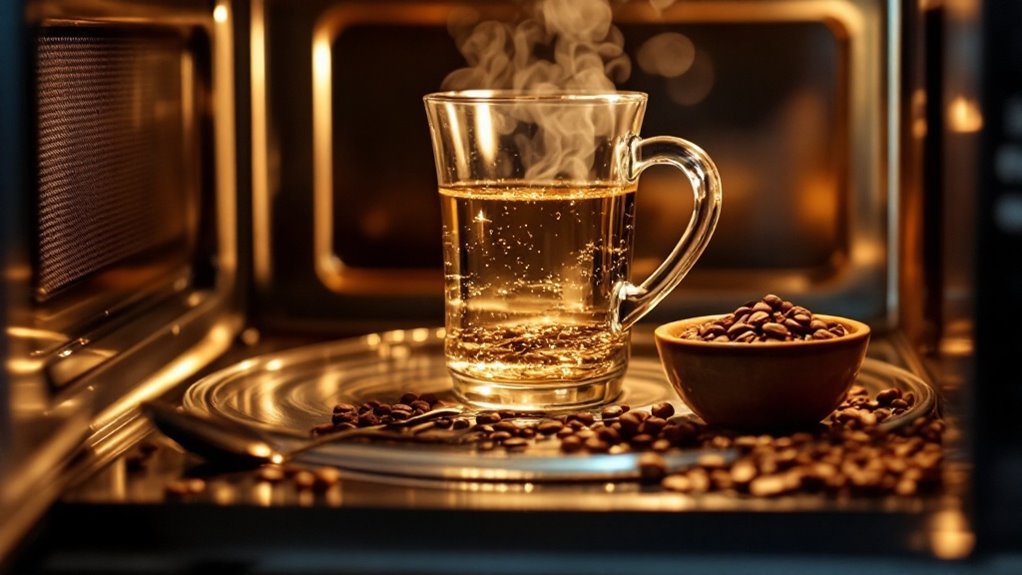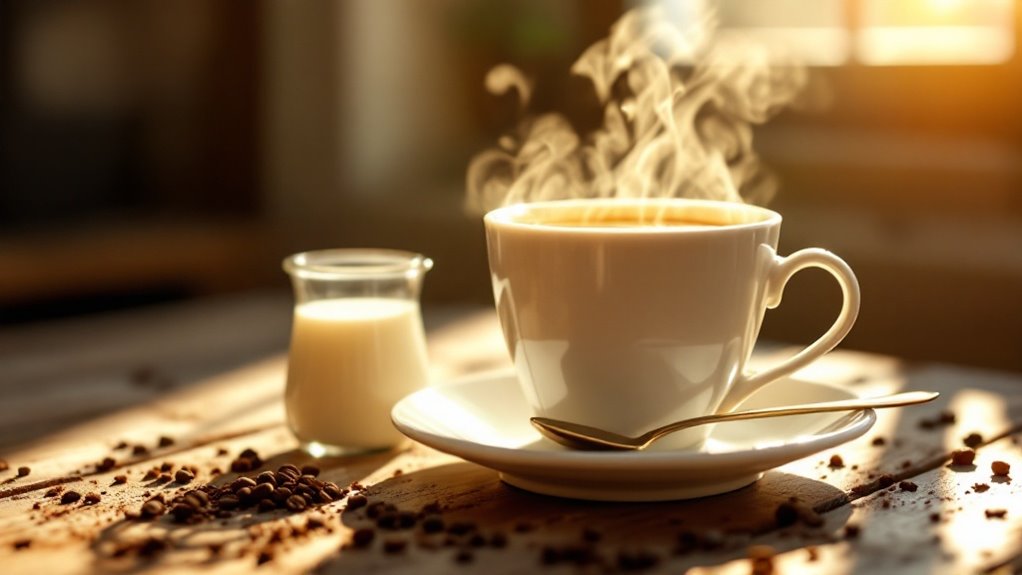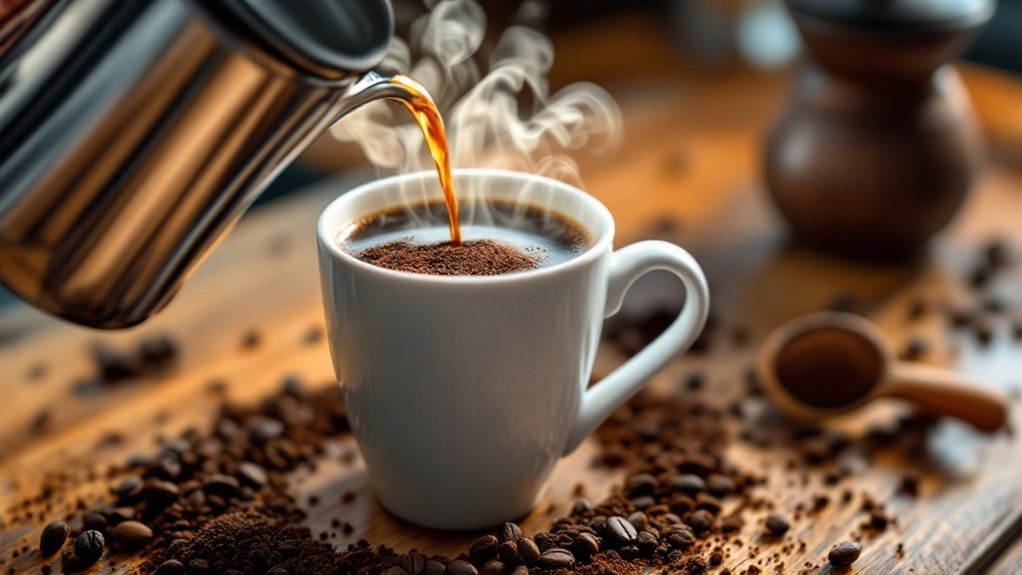







You might think boiling water is the key to a great cup of coffee, but it's not that simple. The temperature you use can make or break your brew, influencing everything from flavor balance to acidity. Too hot, and you risk bitterness; too cool, and your coffee might taste flat or sour. The sweet spot lies between 195°F and 205°F, but even that range isn't one-size-fits-all. Factors like roast level and brewing method come into play, raising questions about how to fine-tune your process. So, how do you find the perfect temperature for your favorite beans?
Key Takeaways
- The best water temperature for brewing coffee is 195°F–205°F (90°C–96°C) for balanced extraction and optimal flavor.
- Light roasts benefit from higher temperatures (206°F–208°F) to extract complex flavors, while dark roasts perform best at 195°F–200°F to avoid bitterness.
- Cold brew requires temperatures below 70°F (21°C) and 12–24 hours of brewing for a smooth, low-acidity flavor.
- Common brewing methods like pour-over and French press thrive at 200°F–205°F and 195°F–200°F, respectively, depending on roast level.
- Use precise temperature control tools like electric gooseneck kettles or infrared thermometers to avoid over-extraction or under-extraction.
How Water Temperature Impacts Coffee Flavor
The temperature of your water plays a critical role in shaping the flavor profile of your coffee, as it directly influences the rate and efficiency of extraction. Water Temperature Affect is a key factor in determining whether your coffee taste will be balanced, bitter, or sour. When your brewing temperature is too high (above 205°F), it accelerates extraction, dissolving bitter compounds like tannins and masking nuanced flavors such as caramel or fruit. This can lead to an over-extracted, harsh cup. Conversely, if your water is too cool (below 185°F), it slows extraction, leaving behind essential oils and acids. This results in under-extracted coffee that tastes flat, weak, and overly acidic. At ideal temperatures (195°F–205°F), you'll achieve a balanced flavor profile, with sweetness, body, and acidity harmonizing perfectly. Cold brew, brewed at room temperature or below, bypasses these challenges by extracting over 12-24 hours, producing a smooth, low-acidity coffee with malted and sweet notes. Understanding how Water Temperature Affect impacts your coffee taste guarantees you can tailor your brewing temperature to highlight the desired flavors in your cup.
The Ideal Temperature Range for Brewing Coffee
You'll achieve the best coffee extraction by maintaining water temperatures between 195°F and 205°F, as this range balances acidity, sweetness, and bitterness. If you brew below 195°F, you risk under-extraction, resulting in weak and sour flavors, while exceeding 205°F can lead to over-extraction and bitterness. Adjust your temperature slightly based on roast level—light roasts benefit from 206°F–208°F, while dark roasts perform better at 195°F–200°F to avoid over-extraction.
Optimal Brewing Temperature Range
Brewing coffee at the right temperature is essential for achieving a balanced and flavorful cup. The ideal temperature for coffee brewing falls within a narrow range of 195°F (90°C) to 205°F (96°C). This range guarantees peak extraction during the brewing process, allowing you to access the full spectrum of flavors without introducing undesirable characteristics. The Specialty Coffee Association recommends 200°F (93°C) as the sweet spot for most brewing methods, as it consistently produces a well-rounded and balanced cup.
If your water temperature drops below 195°F, you risk under-extraction, which results in weak, sour, and overly acidic coffee. Conversely, exceeding 205°F can lead to over-extraction, causing bitter, astringent, or burnt flavors. For light roasts, aim for slightly higher temperatures (206°F–208°F) to compensate for their denser structure, while dark roasts perform better at the lower end of the range (195°F–200°F) to avoid excessive bitterness. By adhering to these guidelines, you'll secure your brewing process maximizes flavor and consistency.
Impact on Flavor Profiles
Water temperature directly influences the flavor profile of your coffee by affecting extraction rates and the solubility of compounds. When you brew at 195°F to 205°F, the water effectively dissolves sugars, acids, and oils, creating a balanced cup with sweetness, brightness, and body. If the temperature exceeds 205°F, over-extraction occurs, pulling excessive bitter compounds and tannins, which overwhelm the coffee's natural flavors. Conversely, temperatures below 195°F lead to under-extraction, leaving behind undissolved solids and resulting in a sour, weak brew lacking complexity.
Lighter roasts, with their dense structure, require higher temperatures (around 205°F) to fully extract their delicate floral and fruity notes. Darker roasts, already more soluble due to extended roasting, benefit from slightly lower temperatures (around 195°F) to prevent bitterness and preserve their rich, chocolatey undertones. Cold brew, brewed at or below 70°F, bypasses high-temperature extraction entirely, yielding a smooth, low-acidity profile over an extended period. By controlling water temperature, you can tailor the flavor profiles of your coffee to highlight its unique characteristics, ensuring a satisfying and nuanced cup every time.
Temperature Adjustments by Roast
To achieve ideal extraction, adjust your brewing temperature based on the roast level of your coffee beans. For light roast coffee, use slightly higher temperatures, typically between 206°F and 208°F (96°C–97.8°C). The denser structure of light roasts requires more heat to fully extract their delicate floral and fruity notes. For dark roast coffee, opt for lower temperatures, ranging from 195°F to 200°F (90°C–93°C). Dark roasts are more porous and soluble, so lower temperatures prevent over-extraction and bitterness, preserving their smooth, rich flavors. Medium roast coffee performs best within the standard range of 195°F to 205°F (90°C–96°C), offering a balanced extraction that highlights both acidity and body. By tailoring your brewing temperature to the roast level, you guarantee peak flavor extraction. Light roasts benefit from higher temperatures to reveal their complexity, while dark roasts thrive with lower temperatures to maintain their inherent sweetness and avoid harshness. Medium roasts, being versatile, adapt well to the middle range, delivering a harmonious cup. Adjusting temperature based on roast level is key to achieving the best possible brew.
Adjusting Temperature Based on Coffee Roast
For light roast coffee, use water between 206°F and 208°F to effectively extract its complex flavors and dense structure. Dark roast coffee benefits from lower temperatures, ideally 195°F to 200°F, to prevent over-extraction and excessive bitterness. Medium roast coffee achieves a balanced profile when brewed within the standard range of 195°F to 205°F, ensuring ideal sweetness and acidity.
Light Roast Temperature Tips
Light roast coffee demands careful attention to brewing temperature to reveal its full potential. Due to its denser structure, light roast coffee requires slightly higher brewing temperatures, typically between 206°F and 208°F (96°C–97.8°C), to achieve proper extraction. These elevated temperatures help break down the coffee's complex compounds, ensuring a balanced extraction that highlights its bright, acidic, and fruity notes. If you brew light roast coffee at temperatures below 195°F (90°C), you risk under-extraction, resulting in weak, sour flavors that fail to capture the roast's nuanced profile. For ideal results, aim for a range of 200°F–205°F (93°C–96°C), which strikes a balance between acidity and sweetness while preserving the delicate flavors. Experiment within the 195°F–205°F range to fine-tune the extraction, adjusting for your preferred taste profile. Higher temperatures around 205°F (96°C) are particularly effective for enhancing the vibrant characteristics of light roast coffee. By carefully controlling brewing temperatures, you'll access the full spectrum of flavors inherent in light roast coffee, ensuring a well-rounded and satisfying cup.
Dark Roast Temperature Tips
Dark roast coffee requires a different approach to brewing temperature compared to lighter roasts. To brew coffee with dark roast beans effectively, you should use a lower temperature, ideally between 195°F and 200°F (90°C–93°C). This range helps prevent over-extraction, which can lead to bitter coffee tastes. Dark roast coffee is less dense due to prolonged roasting, making it more soluble and prone to releasing harsh, burnt compounds if exposed to higher temperatures. By lowering the temperature, you preserve the smooth, rich flavors characteristic of dark roasts while minimizing astringency.
For methods like French press or pour-over, aim for the lower end of the range, around 195°F (90°C). This adjustment enhances the natural sweetness of dark roast coffee and reduces the risk of bitterness. Avoid exceeding 200°F, as it can over-extract the beans, resulting in an unpleasant, burnt flavor. By carefully controlling the temperature, you guarantee that your dark roast coffee tastes balanced, with a full-bodied profile and minimal harshness. Always monitor your water temperature to achieve consistent results.
Medium Roast Temperature Balance
Brewing medium roast coffee requires a careful balance of water temperature to reveal its complex flavor profile. For medium roasts, aim for a temperature range between 195°F and 205°F, with 200°F (93°C) being the ideal starting point. This range guarantees the best extraction of the coffee grounds, balancing sweetness, acidity, and bitterness. If your brew tastes too acidic, increase the temperature slightly, up to 205°F, to boost the extraction of sweeter, caramelized flavors. Conversely, if the coffee tastes overly bitter or burnt, reduce the temperature to around 195°F to slow extraction and preserve delicate notes. Medium roasts are versatile, allowing you to fine-tune the flavor profile by adjusting the temperature within this range. Always use a thermometer or temperature-controlled kettle to maintain precision when brewing coffee. Small adjustments can greatly impact the final cup, so experiment within the recommended temperature range to find your preferred balance. By mastering this balance, you'll access the full potential of medium roast coffee, highlighting its nuanced flavors without over-extracting bitter compounds.
Equipment for Precise Temperature Control
Several tools and devices are essential for maintaining precise water temperature during coffee brewing. Electric gooseneck kettles, such as the Bonavita or Fellow Stagg EKG, allow you to set the exact temperature depending on your coffee's roast level, ensuring you achieve the right temperature between 195°F and 205°F. These kettles prevent overheating, which can extract bitter compounds, or underheating, which leads to under-extraction. SCAA-certified drip coffee makers, like the Technivorm Moccamaster, automatically heat water to 200°F, ideal for consistent extraction. For manual brewing methods, infrared laser thermometers, such as the Etekcity Lasergrip, let you measure hot water or slurry temperatures without direct contact, ensuring accuracy. Built-in thermometers in devices like the AeroPress with a temperature-controlled base simplify monitoring, so you don't need to guess if your water is too hot or too cold. Preheating your brewing equipment, such as French presses or pour-over cones, minimizes heat loss, ensuring hotter water maintains its temperature throughout the process. By using these tools, you can achieve precise control over your brewing temperature, optimizing flavor extraction and consistency.
Cold Brew: A Unique Approach to Temperature
Cold brew coffee offers a distinct method of extraction by utilizing particularly lower temperatures, typically between 68°F and 72°F, compared to traditional hot brewing techniques. This approach minimizes the extraction of bitter compounds and oils from coffee beans, resulting in a smoother, less acidic flavor profile. The extended brew time, ranging from 12 to 24 hours, compensates for the reduced solubility of coffee compounds at cooler temperatures, ensuring a balanced extraction. By avoiding high heat, cold brew highlights floral and fruity notes while reducing the likelihood of a bitter finish. The process involves steeping coarsely ground coffee beans in cold or room-temperature water, which allows for a gradual infusion of flavors. Once brewed, the concentrate is often diluted with water or milk to achieve the desired strength. This method is especially effective for those who prefer a milder, less acidic cup of coffee. Cold brew's unique temperature and brew time combination make it a versatile and invigorating alternative to traditional hot brewing methods.
Common Mistakes in Brewing Temperature
While cold brew relies on lower temperatures for its unique extraction process, achieving the right temperature in hot brewing methods is equally important but often mishandled. One common mistake is using boiling water (212°F/100°C) directly, which can over-extract coffee, especially with finer grind sizes, resulting in bitter and burnt flavors. Conversely, brewing below 195°F (90°C) often leads to under-extraction, producing weak, sour, and unbalanced coffee, particularly with coarser grinds. Failing to preheat your brewing equipment, such as a French press or pour-over cone, can cause significant temperature loss, leading to inconsistent extraction and a subpar cup. Additionally, ignoring the roast level when setting your brewing temperature can amplify bitterness; dark roasts, for example, require slightly lower temperatures to avoid astringency. Reheating water is another error, as it reduces oxygen levels, negatively impacting flavor and extraction efficiency. To make coffee that highlights the nuances of your roast coffee, always aim for a temperature range of 195–205°F (90–96°C) and adjust based on grind size and roast level. These adjustments guarantee balanced extraction and peak flavor.
Tips for Perfecting Your Brewing Temperature
Perfecting your brewing temperature starts with understanding the critical role it plays in extraction. Use a thermometer to guarantee your water temperature stays within the ideal range of 195°F to 205°F, as this promotes balanced extraction and avoids under- or over-extraction. Preheat your brewing equipment, such as your dripper or French press, to minimize heat loss and maintain consistent water temperature throughout the brewing process. Adjust the water temperature based on your coffee's roast level: aim for 200°F–205°F for light roasts to enhance their delicate flavors and 195°F–200°F for dark roasts to prevent excessive bitterness. If you're using boiling water, let it cool for 30 seconds before brewing to avoid scorching the grounds and creating an overly bitter cup. For precision and repeatability, invest in a gooseneck kettle with temperature control, which allows you to fine-tune the water temperature for each brew. By mastering these techniques, you'll achieve a consistently balanced extraction, highlighting the nuanced flavors of your coffee.
Disclosure: As an Amazon Associate, I earn from qualifying purchases.






